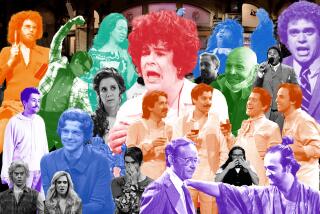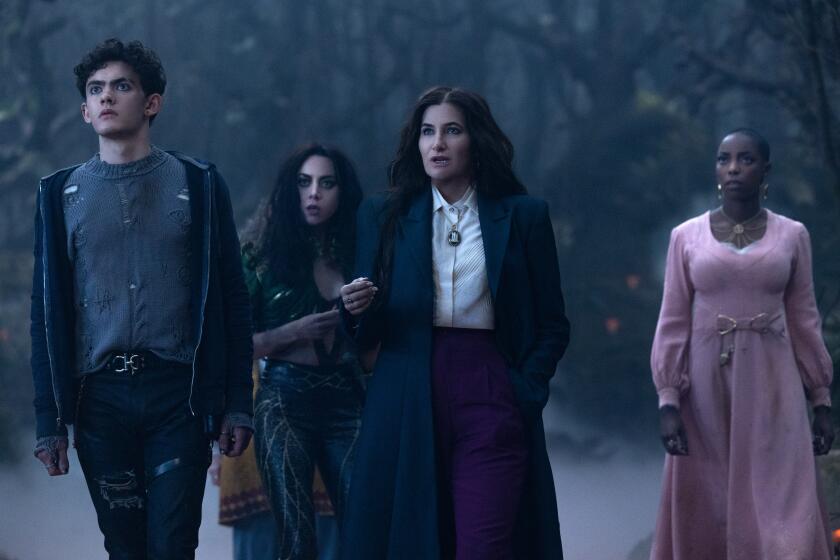Showplace From Another Era Is an Active Heirloom
In a neighborhood distinguished by vintage elegance, the grande dame of genteel grace can be found at the southwest corner of Wilshire and Lucerne boulevards.
For good reason, too. Women built the Wilshire Ebell Theatre. And for more than three-quarters of a century, women have operated it as a cultural centerpiece for Los Angeles.
The 1,270-seat hall and its 48-foot stage is one of the busiest in Southern California. Built in a stately Italian Renaissance style, the auditorium is also one of the area’s most striking.
It’s part of the villa-like Wilshire District headquarters of The Ebell of Los Angeles, a nonprofit women’s education and social club.
The club’s 500 members sometimes use the ornate theater for lectures, concerts and travelogues, just as they have since 1927. That is when the women borrowed $750,000 to construct it and a sprawling adjoining clubhouse.
It was an audacious undertaking for any group, let alone for women struggling to forge their own identities shortly after winning the right to vote.
The women commissioned architects Sumner Hunt and Silas Burns to draw up the structure. Their design was audacious, too.
They put the 187-foot-wide auditorium on the back of the property, with its entryway and box office hidden beneath an arched, tile-topped veranda. The theater actually faces 8th Street.
A two-story front wing of the building is taken up by a sprawling club lounge that faces Wilshire Boulevard with a 150-foot frontage. Next to it is an arts salon and, across a hallway, a large dining room.
The dining area opens into a garden courtyard that is walled off from Lucerne Boulevard by a tile-roofed colonnade walkway. A gurgling fountain screens the noise of nearby traffic.
The Ebell clubhouse was heavily used from the day it opened on Oct. 3, 1927.
The group listed more than 3,000 members at the time and women were organized into more than a dozen “departments” that conducted classes and seminars on such topics as psychology, parliamentary law, language and travel.
Experts were brought in to teach the women how to perform Shakespeare. There were Bible study and instruction in music, gardening and science.
The program was an outgrowth of an educational effort begun in 1884 in downtown Los Angeles by a self-styled professor and adventurer named Adrian Ebell.
He advocated education of women and their active participation in community affairs; the clubhouse theater gave the women of Los Angeles a venue to carry out their mission.
The mahogany-paneled auditorium was initially called the Windsor Square Playhouse. It’s first production came in late 1927 with the West Coast premier of “Desert Song.”
It is said that during one of the show’s auditions, a talent scout first spied Judy Garland and recruited her for a screen test that launched her Hollywood career.
The auditorium was used nonstop for lectures, sermons and other public events. In 1937, aviator Amelia Earhart gave her last public speech at the Ebell before attempting her around-the-world flight, during which she disappeared.
These days the Wilshire Ebell Theatre, as it’s now known, is booked as many as 150 days a year for everything from theatrical productions to opera.
This month’s shows have included Korean dancing, a young musicians’ orchestral concert, an environmental group’s award show, three religious services, a Latin American benefit, a Russian variety show, a travelogue, a ballet performance, an Israeli comedy show and a charity fund-raiser featuring Debbie Reynolds and Tony Danza.
The theater’s popularity can be traced to its distinguished look, its not-too-large size and the fact that it is affordable to rent, said Michael O’Connor. With his wife, Virginia, he manages the theater for the Ebell club.
“A small group can come in and experience a full theatrical production in a great building,” he says. At $4,000 per show, “we haven’t out-priced ourselves.”
The auditorium is heavily used by various ethnic groups that bring in entertainers from overseas, he said.
“Everybody knows how diverse Los Angeles is. But you have to come here to really see for yourself,” said O’Connor.
“It’s an evening they can come in and be engrossed with a thousand others from their homeland. The star on the stage may be an artist they haven’t seen in 20 or 30 years, since they were in their home country. Some have tears in their eyes.”
Shows staged in Farsi, Korean or Russian can leave members of the Ebell stage crew scratching their heads, however.
“We do a lot of gesturing and pointing when there’s nobody on stage who speaks English,” said Bob Bigelow, who has been the Ebell’s stage manager for 18 years. “You can generally spot the headliners. Their costumes are different and everybody is looking at them.”
But some shows, such as this week’s Reynolds-Danza event, “really blow your socks off,” Bigelow added.
Singers such as Nancy Wilson, Roberta Flack, Rita Moreno, Sharon Stone and Toni Tennille have performed over the last 10 years at the Ebell in an annual AIDS benefit called “Divas Simply Singing.”
With ticket prices ranging from $35 to $250, this year’s Oct. 25 concert benefited Project Angel Food and the Black AIDS Institute.
Divas show producer Paul Papile and creator Sheryl Lee Ralph say the fact that the Ebell is nonunion means low-budget shows can use volunteer crew members to help give events a big-budget look.
“We’re able to bring in our own sound and lights. The building is old Hollywood and has a lot of history. And it’s big enough to feel big -- and small enough to be intimate,” Papile said.
Ebell leaders say the theater has an out-by-midnight policy aimed at keeping noise down for those in the residential neighborhood across 8th Street.
“Heavy duty” rock and rap music shows are discouraged in order to protect the building -- which is a Los Angeles Cultural Landmark and is listed on the National Register of Historic Places and as an Official American Treasure by the National Trust for Historic Preservation.
Kay Balue, current president of The Ebell of Los Angeles, said revenue from the theater, along with rental of club property for movie shoots and private functions such as weddings, pays for the old building’s $150,000-per-month upkeep.
With dues of only $95 a year, the members can’t do it by themselves, especially when they continue funding scholarships and convalescent centers for women, as they have been doing since the 1920s, Balue said.
“It’s wonderful we can provide the community a venue with the theater,” she said. “But the community helps us, too.”
More to Read
The biggest entertainment stories
Get our big stories about Hollywood, film, television, music, arts, culture and more right in your inbox as soon as they publish.
You may occasionally receive promotional content from the Los Angeles Times.











